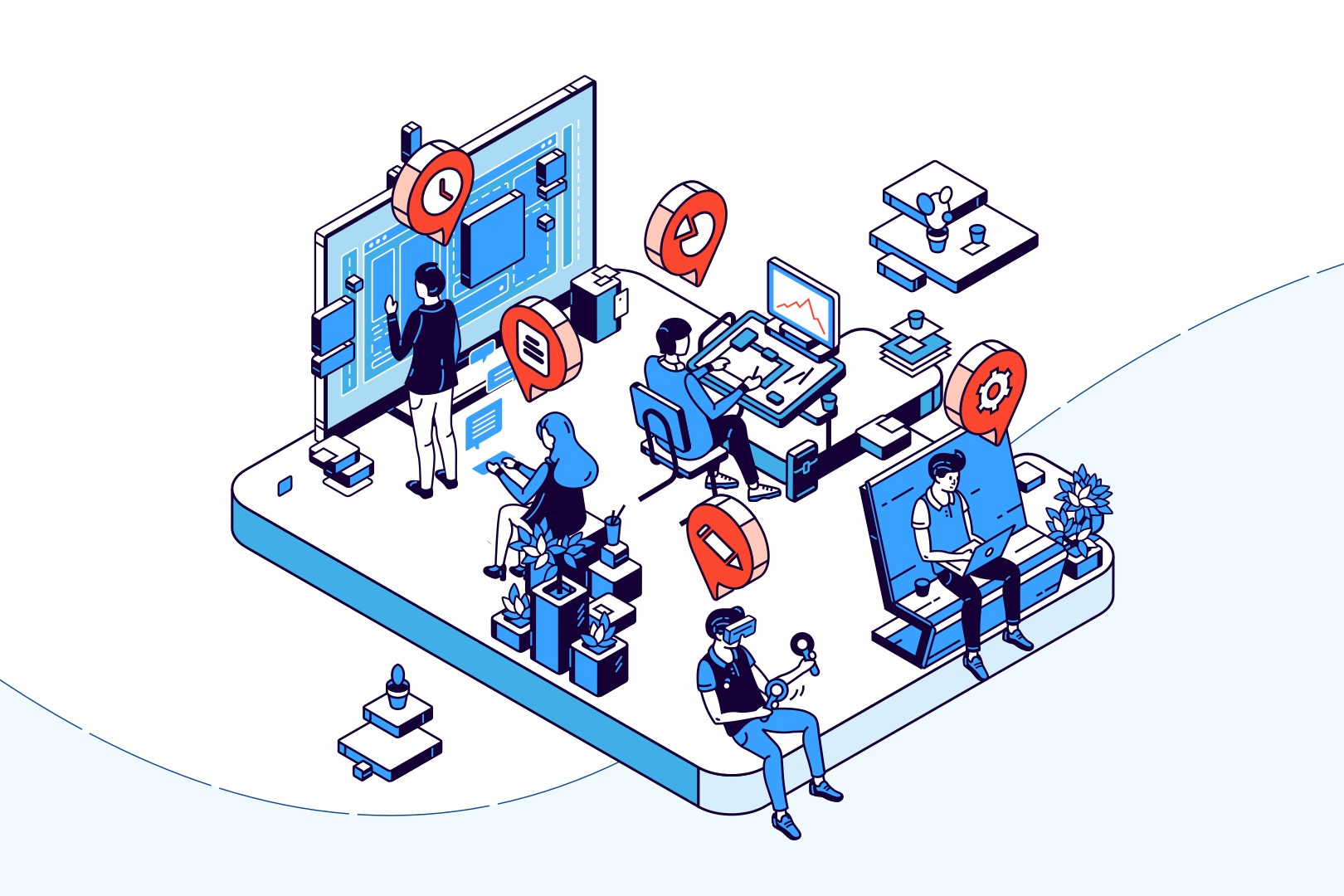We’ll start with the basics in this post and address the question, “Who performs what in your software teams in software development company?” So, will discuss Software Development Team Structure.

Who are in the best Software Development Team Structure
Frontend Developer
The part of your program that users see and interact with directly is created by a frontend developer. They make sure that everyone who utilizes the app has a pleasant and easy-to-use experience.
The frontend developer is responsible for everything your users view. I feel this should be sufficient to persuade you of the significance of their position inside the product development software team structure. They ensure that your users have a seamless experience that is free of delays and unpleasantness. Texts, buttons, navigation bars, and animations are all included.
Your frontend developers’ abilities determine the quality of virtually everything your user interacts with. The most difficult aspect of their job is ensuring that every user has the same experience, regardless of whether they use Edge or Chrome, a computer or a phone, Android or iOS.
It’s a tremendous job, considering how many browsers, phones, wearables, and other smart-stuff we use. Frontend developers are taught how to charm browsers and master resolutions. Without them, we’d have to type commands into the command line on black-and-white monitors to do anything with our computers.
Frontend team-related tools and technologies: JavaScript, HTML, CSS, React, Vue, Angular, React Native, PWA, RWD, Web Browsers.
Backend Developer
The backend developer is in charge of everything that goes on behind the scenes of the program, and they are the ones that will address all of your problems.
The Chief Technological Problem Solver is the key function of the backend developer in the software development team. All the magic happens beneath the hood thanks to the individual who designs intricate and sophisticated algorithms and application logic.
Backend developers ensure that your product not only looks great, but also runs smoothly and efficiently. Backend developers are sometimes mistaken for coders. Wrong! They design and create the entire application architecture, deciding which services and databases should connect with one another, how API and external integrations should operate, and how to keep the product secure and reliable.
They’re not simply developers; they’re consultants. A good backend developer not only does what is asked of them, but also looks for the most efficient solutions to problems. If you ask your BE developer to integrate a specific database and the developer understands that an alternative solution will work better for your app, they will almost certainly persuade you to reconsider.
It’s possible that your proposal will take a long time to implement, but the same impact can be achieved faster using a different strategy — backend developers will be aware of this.
Simply specify a problem/desired effect, and a backend developer will identify the most efficient method to implement that meets your requirements. This is how our backend works.
Backend Team-related tools and technologies: Node.js, PHP, Databases, SQL, Algorithms, Microservices, Architecture.

Quality Assurance Engineer
QA Engineers ensure that your program is bug-free, supports all devices/browsers, and complies with all specifications.
Software development is a difficult and error-prone field, and even the most experienced software developer will not be able to create faultless solutions on their own. This is why having a Quality Assurance Engineer on board can be beneficial to any software development team.
What are the responsibilities of QAs? Simply said, they detect faults and issues before your users do. QA specialists pay close attention to performance, security, usability, portability, and the appearance of your program from the end-perspective user’s while testing it. They are more than just testers; they also ensure that developed features satisfy the requirements (which they helped to define beforehand), write documentation, build test cases, and actively contribute to the project’s best development practices.
Their contribution is crucial in creating a high-quality product, a seamless end-user experience, and meeting project objectives. They are not just time savers, but also irreplaceable headache savers in the long term.
QA Team-related tools and technologies: QA Touch, Postman, Test Flight, Confluence, Burp
Quality Assurance Automation Engineer
QAA Engineers create automated tests, which are simple programs that run in the background and continuously test your application, letting you know quickly if something goes wrong.
While the Quality Assurance Engineer ensures that every new feature is thoroughly tested, previously existing features may fail. It might be the depreciation of an API key or an external plugin, or it could simply be that something went wrong when releasing a new feature.
It’s physically impossible for your quality assurance team to test the entire product every day. So you may either wait for defects to be reported by your users… Alternatively, you can hire a Quality Assurance Automation Engineer.
Designing and developing automated tests, such as “end to end tests” that imitate genuine user behavior and alert the team quickly if something goes wrong, are among QAA’s tasks. It’s like having a magic wand that makes the program constantly test itself.
It’s almost as if it were a magic wand… Because not everything can be automated, you can’t just run an automated test on every line of code and call it a day. Implementing automated tests is difficult, to say the least; they must be dependable, maintainable, and provide immediate feedback.
It’s a lot easier to write a test that not only doesn’t prevent problems, but actually causes them. A good QAA will analyze your app and recommend which functionalities should be automated and which should not in order to get the highest return on investment possible. A knowledgeable QAA will ensure that you save as much time and money as possible when it comes to testing and bug fixes.
QAA Team-related tools and technologies: JavaScript, Kakunin, Cypress, Puppeteer, Protractor, Artillery, Appium, Web Browserm, Apptester

DevOps Engineer
DevOps experts ensure that your solution is available 24 hours a day, 7 days a week, is cost-effective to maintain, upgrade, and maintain, and can withstand both abrupt user activity surges and earthquakes.
So your team has created a cutting-edge application. You asked a group of pals to try it out, and they fell in love with it right away. You’re ready to show the world your new creation; all you have to do now is release the app and watch your bank account explode with cash.
Isn’t there anything that could possibly go wrong? You discover an hour after releasing your app that it is ten times slower than when you tested it, that people from other countries need ten seconds to load the main page, and, worst of all, that the app has already crashed… seven times… in 15 minutes. It’s not a horror story; it’s a legacy infrastructure that was badly designed and optimized. In today’s world, two years old is already considered a legacy.
Solving the aforementioned issues is a job for DevOps Engineers, an infrastructure commando who isn’t frightened of new difficulties. It is their responsibility to upgrade your infrastructure. Their bread and butter is infrastructure as code, automated procedures, scalable, robust, and personalized cloud solutions.
Your DevOps Engineer ensures that your app is quick, safe, and accessible to people all around the world. Your program must be able to handle large increases in user traffic without being overburdened, and it must remain available even if the entire server warehouse is on fire.
“Will this cost me my kidney?” you’re presumably thinking. Here’s the best part: depending on business demands, a qualified DevOps Engineer will ensure that your infrastructure grows up and down as needed. You will only be charged for what you actually require and utilize virtually. This puts you in the sweet spot, allowing you to have both minimal costs and good performance. In the long run, DevOps’ role is to ensure that every dollar spent on DevOps returns more than $1.
DevOps team-related tools and technologies: AWS. Azure, Cloud Computing, Docker, Continuous Integration/Delivery, Kubernetes, Ansible, Terraform.
Product Designer
Product designers assist you in translating your product vision into user-friendly designs and creating user journeys that optimize the user experience and increase conversion rates.
You may have heard them referred to as UX designers, UI designers, information architects, user-pleasers, and a variety of other terms. Product Designers are needed for the application development team. They are critical to the success of the product you create. People often think of them as graphic designers who develop attractive designs.
While it’s true that Product Designers ensure that your application’s feel and design, as well as the entire user interface, are as sharp and appealing as possible, this isn’t their only role. They’ll be a part of your team throughout the whole software development process, from translating your business goals into usable user experiences to analyzing, assessing, and improving those experiences over time.
Many people are surprised to learn that they are also data masters: they observe every change in conversion rates, click rates, and other metrics, draw inferences, and provide solutions to ensure that your measurements support your business goals. Product designers are essential parts of any development team if you want your consumers to fall in love with your products and, more crucially, convert through your sales funnels.
Product Design team-related tools and technologies: Sketch, Figma, inVision, Zeplin, Adobe CC, Story Map, Principle, Piece of paper, Pencil

Project Manager
A project manager who considers everything that could go wrong and makes sure it doesn’t, ensuring that your project is completed on time and on budget.
Project managers keep the project on track, which is a difficult task in the world of IT software development. They ensure that the team is engaged and productive, that risks are identified and monitored, and that the highest development and communication standards are adhered to.
Project management serves as a link between the world of business and the world of IT jargon. A PM has a unique view on the product and process since he or she has one foot in the software development team and the other in the business side as a consultant.
When something unexpected occurs, such as a team member becoming ill or the application failing to function, a Project Manager ensures that the problem is quickly resolved and, if possible, avoided in the future. They also seek for ways to optimize the entire development process to ensure that the team provides more value faster with each iteration. Having effective project management in your team helps you to concentrate on your product and business rather than keeping track of every last detail.
Project management team-related tools and technologies: Product Roadmap, Burndown Chart, Release Plan, Jira, Risk Register, Budget Tracker, Project Charter.
Business Analyst
If you want to refine or validate your company idea and make sure you’re spending your time and money wisely, this is your best friend.
The majority of goods fail not because they were badly built, but because they failed to meet the product-market fill expectations. A Business Analyst can help you avoid this dilemma by ensuring that you are developing the correct product at the right time to tackle the right problem, and that it is consistent with your overall business model and customer expectations. According to research, devoting 8 to 15% of time and resources to business analysis increases the likelihood of project success dramatically. A Business Analyst assists you in developing a product vision and creating requirements based on the needs of your consumers and stakeholders, as well as verifying whether you are on the correct route.
Related tools and technologies for business analysis team: Storymap, Product Backlog, Business Model Canvas, Value Proposition.

To summarize, developers and well-written, clean code are rarely enough to assure a project’s success, therefore make sure to include other key people in your development team. So, Your project’s success can be determined by the organization of your software development team.


